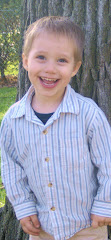 Today we began our reading program. I started off with animals, because that is what he is really into these days. There's no hat, cat and sat in teaching two-year olds. More like elephant, motorcycle, and humerus.
Today we began our reading program. I started off with animals, because that is what he is really into these days. There's no hat, cat and sat in teaching two-year olds. More like elephant, motorcycle, and humerus.Nonetheless he loved it. I made a book of "couplets" (two words, such as purple butterfly) with pictures on the following page. I knew that he wouldn't go for just the words, unless those words meant a step into him being able to read books. He loves books, and isolated words aren't very interesting to him unless they mean something - which in this case means being able to read books.

A few months ago I tried teaching him the names of everyone in his family. He lost interest right away. The words didn't mean anything to him because he couldn't use them. But now that he has a book in his hands demonstrating those words being used, he's totally interested in reading them.
He's really excited about reading. Today he asked to see the word about four times, and each time I showed them to him he begged "Again!" His toy animals were even asking to see them.
We're hoping to do about 200 words by the end of April. We will be making lots of homemade books, and many, many words. We make them very big and very bold (and red, because it's attractive) so that his little eyes can see them easily as I show them very quickly (flashing speed of less than a second per word). We'll be having a great time opening doors to learn new things about our world.
But what about phonics?
Acdicorng to a rcesearh at Cbmraigde Uinsiertvy, it deson't mtaetr waht odrer the lteetrs in a wrod are in, the olny ipmroatnt tihng is taht the frsit and lsat lteter be in the rgiht plcae. The rset can be a taotl mses and you can slitl raed it wtiuot a porlbem. Tihs is bceasue the mnid deos not raed erevy lteter by isteslf, but the wrod as a wohle, and the barin fgiuers it out aynawy. Cool!If you can read the sentence above, then you're probably a decent reader. The words are all mixed up, but you can read it anyway because the first and last letter are in the right place. That's because our brains read whole words and even whole sentences at once, not letter by letter. That is why there are many words that you can read just fine but you cannot spell. Reading is a brain function that humans are born with. You do not have to have a knowledge of phonics or even know the alphabet in order to read, just as you do not have to have knowledge of grammar or spelling in order to speak.
Understanding that words are made up of letters and sounds is an important skill to have. But so is understanding that sentences are made up of nouns, verbs, and prepositions. But that never stopped us from teaching children how to speak.
Reading is a brain function, just as is speaking, and children can learn how to read words long before they can understand the technicalities of phonics. Giving them a head start in reading will make phonics come easy (and actually make sense).
"Very young children can and do learn to read words, sentences, and paragraphs in exactly the same way they learn to understand spoken words, sentences, and paragraphs.
Again the facts are simple - beautiful but simple. We have already stated that the eye sees but does not understand what is seen and that the ear hears but does not understand what is heard. Only the brain understands.
When the ear apprehends, or picks up, a spoken word or message, this auditory message is broken down into a series of electrochemical impulses and flashed to the unhearing brain, which then reassembles and comprehends in terms of the meaning the word was intended to convey.
In precisely the same manner it happens that when the eye apprehends a printed word or message, this visual message is broken down into a series of electrochemical impulses and flashed to the unseeing brain to be reassembled and comprehended as reading.
It is a magical instrument, the brain.
Both the visual pathway and the auditory pathway travel through the brain and where both messages are interpreted by the same brain process.
Visual acuity and auditory acuity actually have very little to do with it, unless they are very poor indeed.
There are many animals that see or hear better than any human being. Nonetheless, no chimpanzee, no matter how acute his vision or hearing, has yet to read the word "freedom" through his eye or understood it through his ear. He hasn't the brain for it." -Glenn Doman, How to Teach Your Baby to Read
Reading whole words or whole sentences at once is indeed true reading. We must stop assuming that a two-year-old who reads a paragraph quickly and easily "isn't really reading", yet the seven year old who slowly and painfully makes his way through a simple sentence ["ttthhhh-uh kaaaa tuh…. Ssss, sssiiii tz, sits oh-nnnn, er, um, ON ttthhh-uh mmaaa-tt." Translation: the cat sits on the mat. Child's understanding of what he just "read": none] is the one who is "really reading".
Keep in mind that if an adult "read" like the seven-year-old we just described, we would call him functionally illiterate. But if an adult reads a thousand words per minute in the same way that the two-year-old just did, then that adult is considered a superb reader.
.jpg)
No comments:
Post a Comment